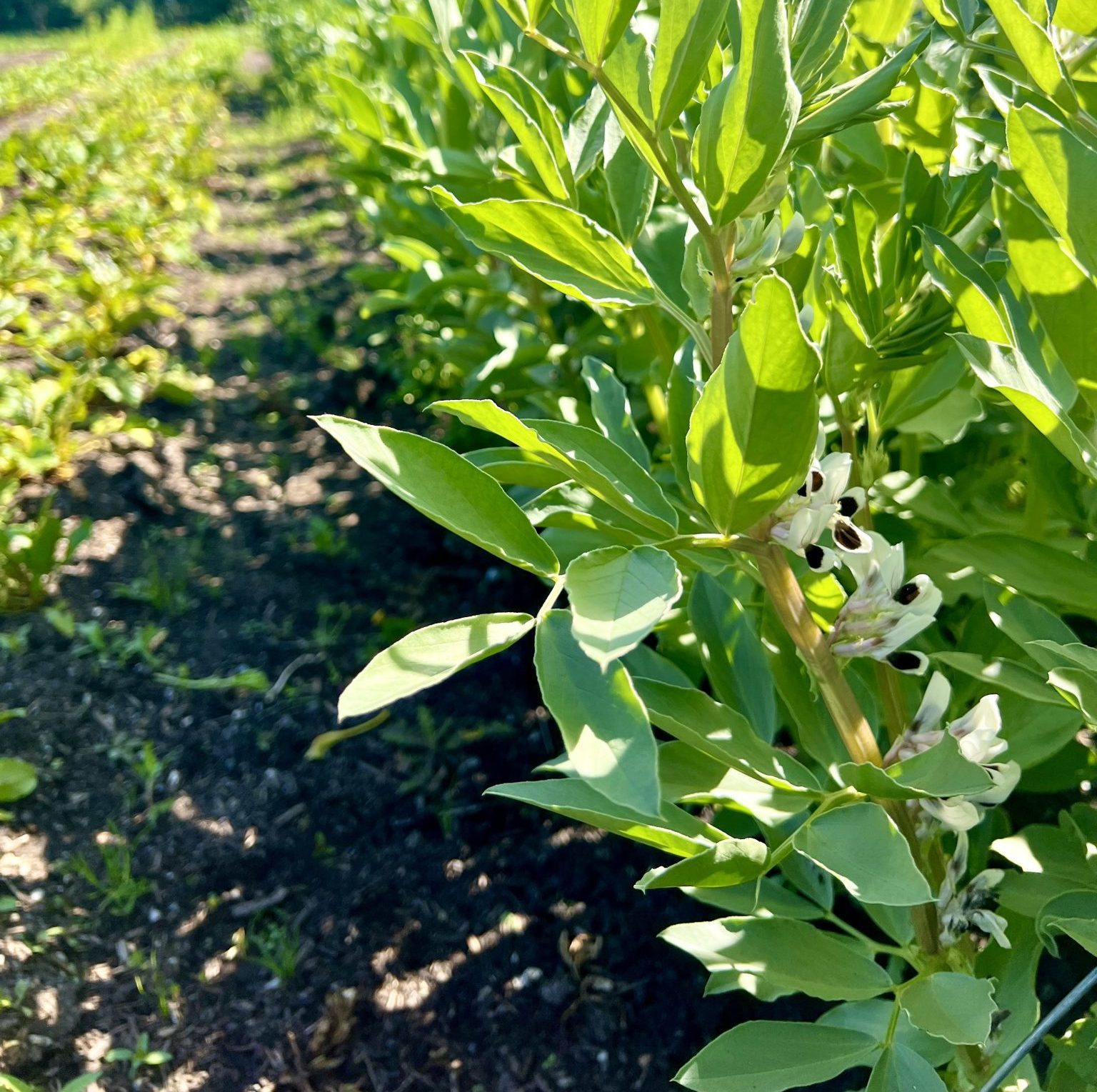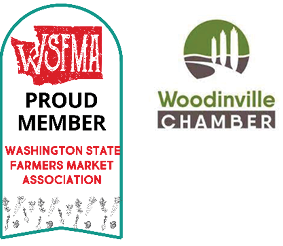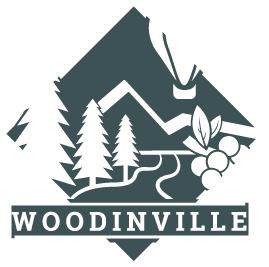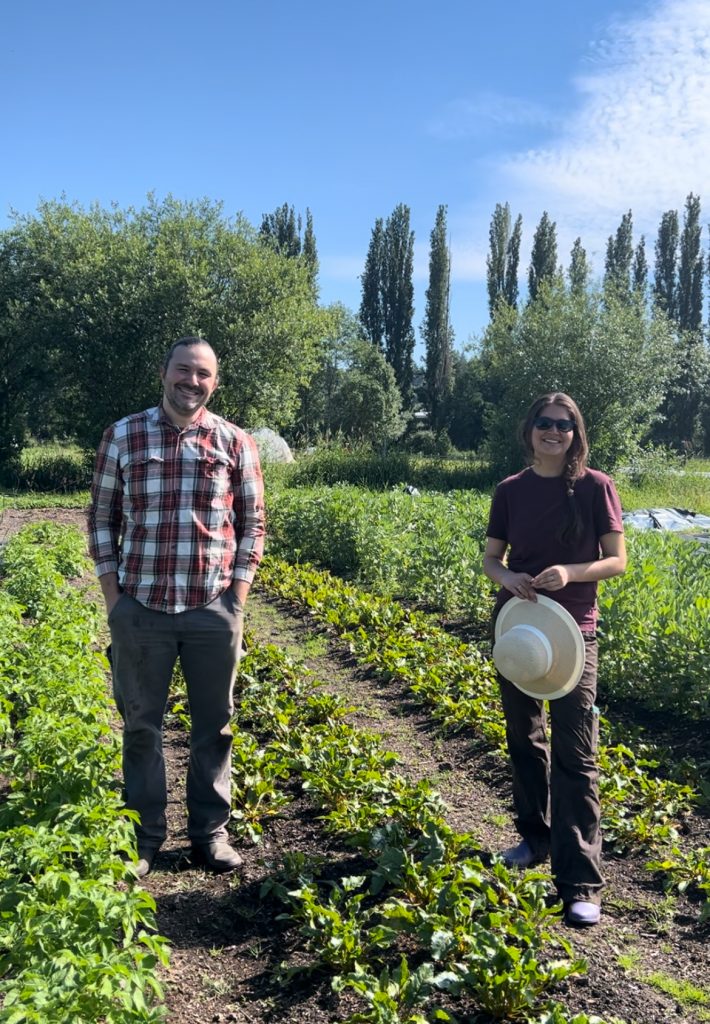
Tyler Morgan and Alex Swidergal
On a sunny Sunday afternoon the second week of June, I creep my truck down a long, curving lane nestled in the bottomlands of the Sammamish Valley. I’m less than two miles from my own home in Woodinville, where I’ve lived more than 15 years, and I didn’t even know this farm road existed. Not far in front of me, I can see the line of cottonwood trees that march continuously along the riverbank from Bothell all the way south to Redmond. Signs on both sides of the road – more of a driveway, really – proclaim Drive Slow, No Dust, Enjoy the View. I spy a row of large red poppies in a field to my right, bending gently in the breeze, petals wide open on this warm spring day.
At the very end of the lane, I pull over and park beside an unassuming, narrow half-acre plot. I’ve arrived at Blue Glass Farm, the sustainability-focused, small scale agricultural labor of love of Alexandra Swidergal and Tyler Morgan. To my right, I spot flats of vegetable and flower starts, waiting their turn for transplanting (I’ll later learn these were sown in the living room of their condo before being brought to the farm). Two large piles of compost sit directly in front of me, thermometers stuck in the center. A long hoop tunnel runs halfway down the west edge, and a tall hedgerow, noisy with birds, runs along the whole length of the back.
Alex greets me with a warm smile. She’s standing next to a pair of wheelbarrows – there’s no tractor here. Everything is done by hand. Tyler joins us, and they lead me out for what they like to call a “tasting tour.”
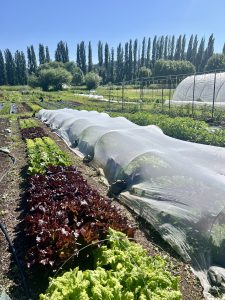
Blue Glass looking southwest
An initial question about irrigation gets Tyler off and running. He’s an engineer by trade, and you can tell in the first few minutes on the farm. He explains their conversion from a drip system to a more economical and effective overhead one by taking pieces of it apart to show me. Inside a small nozzle, he finds a spider with its pillbug dinner blocking the opening. “You can tell we’re organic, no pesticides here,” he says with a smile.
Everywhere I look I see plants I recognize – potatoes (lots of them), tomatoes, cosmos, brassicas, marigolds, more varieties of lettuce than I ever knew existed. They’re all in tidy rows, some with covers or weed plastic between, most without – they use plastic sparingly and only where and when necessary, a rarity in most modern agricultural practices. The crops sit a little high in the ground – Blue Glass follows a deep compost, no till method for natural weed suppression and optimum soil health.
But for every plant I know, there are others I’ve never seen or even heard of, grown together in a colorful patchwork. Alex and Tyler are self proclaimed plant nerds and seed catalog enthusiasts. Here in this half-acre market garden, they grow more than 200 varieties of vegetables, herbs, and flowers (although “technically rat tail radishes are a fruit”). They are wildly productive in this small space. They sell at the Woodinville Farmers Market, 21 Acres, have an online store, and have wholesale clients at local restaurants that value the sort of ultra-fresh, high quality novel crops Blue Glass specializes in.
I learn quickly to keep a free hand available – both Tyler and Alex pluck and pass me leaves of this and that as we walk the rows. Most I don’t even ask what I’m eating until after I’ve tasted it – a chrysanthemum leaf, Tulsi basil, fava bean flowers, something deliciously sour I missed the name of entirely, the aforementioned rat tail radish. We spy ladybugs all over, hard at work. It’s been a bad year for aphids as my own garden attests. I pause as I listen to a common yellowthroat in the hedgerow, and spot both a downy woodpecker and a goldfinch.
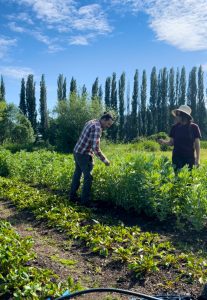
This farm is alive, rich with growing plants, insects creeping in the soil and buzzing among blooms, calling frogs in the ditch, and birds flying from edge thicket to sunflower to trellis pole and back.
Alex and Tyler want it this way – he even calls the farm an “ecosystem” at one point. Alex speaks fondly of the pair of crows she recognizes year to year, one of whom is behind her, perched in a willow bough overlooking a row of lettuce, like he’s there to verify her story.
Their love of the farm is abundantly present and contagious. What follows is a transcription of my interview with them, edited for clarity and length.
E: How long have you been Blue Glass Farm?
A: We started in 2022 as incubator farmers through the Viva Farm program. We were students there in 2021, and applied to the incubator plot program, and were lucky enough to get on this [initial quarter acre] site in March 2022.
T: In 2023 we expanded to the half acre we are at now, which is probably as big we will ever be able to get here.
A: And with two people, a half acre feels good. There’s enough to do.
T: Turns out you can grow a lot on half an acre.
E: Speak to me about your backgrounds in farming. How did you get here?
A: My undergrad is in plant sciences and biological sciences, and then I did a Masters in Agriculture through the WSU Extension Center in Mount Vernon in their global online course. So I have more of a formal education in ag, particularly plant science, but I really only had direct exposure to gardening, and then I had a quarter acre flower farm at my parents’ house for 4 years north of Spokane. So I’d grown stuff before but never veggies, and not quite this scale.
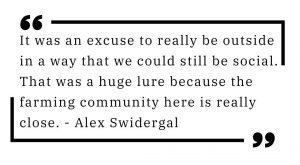
T: I’ve got an engineering background. I’m a mining engineer by formal training. Moving compost feels very natural to me, that sort of materials handling side of things. The business of farming is what got me interested. Seeing that small scale farm economics are so much different than the thousand acre monoculture crop farms we grew up around that are really struggling. You see small farmers actually making a living on an acre, which was just wild to me. Exploring that and seeing what that ecosystem looks like is what drew me.
A: And also 2021 being the pandemic, it was an excuse to really be outside in a way that we could still be social. That was also a huge lure because the farming community here is really close. That’s been super cool.
E: Something that you really love is having lots of interesting varieties. Why?
T: The biggest reason for that is we want to learn a lot. One of the things I realized early on with my background in software – you can figure things out really quickly in software. At a farm, it takes an entire year to figure out “Oh, that’s a really bad crop for us, it did really poorly.” So part of it is just trying to learn as fast as we can and build a taste for what is the best produce out there. That’s what we are slowly trying to work towards. What grows well for us here in the organic ways we are growing things as well as what just tastes really awesome. What do people vibe with? What gets people excited? We are also suckers for seed catalogs.
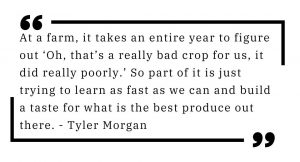
A: *laughs* Yeah, that too.
E: How much time do you spend working out here, week to week to make this farm happen?
A: I’m close to 20 hours a week, maybe a little more. I have a 9-5 job at UW, so I’m nights and weekends.
T: This moved from being my side gig to more of my main gig. I still do some work on the side, some contracting. I think last year my math said we spent about 1800 hours on the farm. And then by the time you’ve done all the computer work – doing listings on the online store, listings with wholesalers, social media, planning, and all of that side there’s probably another 500-700 hours a year.
T: The biggest time suck was moving compost. We moved 130,000 pounds of compost wheelbarrow by wheelbarrow.
E: No tractor for that?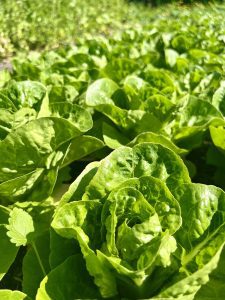
A: Nope.
T: No tractor, no trailer. We don’t use any heavy equipment.
A: We’re farm fit.
E: What’s your favorite part of this kind of farming?
A: I like the variety. It’s a blessing and a curse, but every day is very different. In a regular 9-5, I’ll show up in the office and a lot of the work is similar. Getting to really experience a lot of stuff that changes so often is my favorite part.
T: Eating produce is really good. Part of the inspiration for starting the farm is there were crops that I wanted to be able to eat. I love Thai food, and the difference between really good Thai food and okay Thai food is that they have access to the right ingredients. And people just don’t grow them here. You can find some of it at H Mart and whatnot but almost all of the really specialty ingredients are coming from Mexico or Southeast Asia. And the quality is just not there. Having this farm blew my expectations for what good produce should be out of the water. Because all of the sudden we were growing even more interesting varieties than we’d ever had and getting to taste the most amazing tomatoes. We’ve become huge lettuce nerds. Who’s a lettuce nerd?
*Everyone laughs*
T: It’s so good! Brown Gold Ring is… I just can’t tell people enough. The sweet crispy leaves. They’re so good… *trails off in lettuce euphoria*
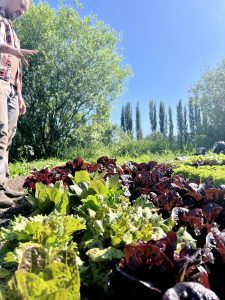
E: What are your biggest challenges?
T: Land access. It’s not one that hits us every day. We’ve got the half acre lease here and development pressure in the valley is really one of the biggest things.
E: So long term, that’s going to be a big challenge.
T: We live in Bothell. We live close enough that some days I bike down the Burke to get here. We’d like to stay in the valley. We care about the area. We care about the community. I don’t want to learn here to go move out to Wenatchee or something. Our goal is to be here.
T: Day-to-day, I’d say weed management. It’s a huge part of the reason we deep mulch. We have very very healthy soil and it shows up in our weed population. There’s all kinds of really fun weeds out here that just love it. Happy soil, happy weeds. Staying on top of those is one of our biggest challenges. 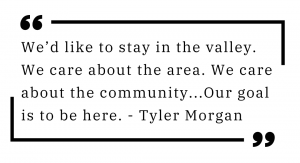
All three of us pause, enraptured, as a great blue heron flies directly overhead. We watch as it circles back and drops down 20 yards behind us in the thicket bordering the back of Blue Glass. It’s a brief moment of bated-breath nature magic when you can feel the delight in their wildlife neighbors hasn’t worn off.
E: Last question’s a fun one. If you could be any vegetable, what would you be and why?
T: Garlic. It just gets to hang out a long time. And it’s really surprising once you finally get to it.
A: We did a google search for… like “knee high by 4th of July” for corn, and I was curious if there was a saying for garlic. There isn’t really one, but one I did see was “shallots are for children, onions are for men, and garlic is for heroes”.
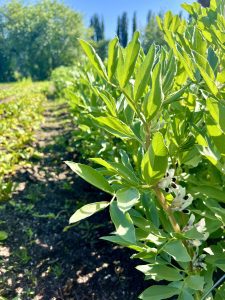
Which I thought was excellent.
T: Alex would be a flower of some kind.
A: She said vegetable. I can’t be a flower!
E: This is Blue Glass, we can open it up. Anything you can grow.
T: Technically rat tail radishes are a fruit.
A: This is true.
A: I think I would be Dara, or Queen Anne’s Lace. It grows wild around here. It’s invasive, but the fancy version is what I grow, and it’s not. It’s got this really cool history. There’s lore about it coming across the Oregon Trail. It’s very delicate and pretty and dainty, but also really hardy and takes over. Seems appropriate.
T: *laughs* Expands into the space you give it. That’s very much true. She’ll use any space.
At least in their little corner of the valley, Alex and Tyler have made an art of using the space they’ve got. Whether it’s a plethora of novel crops or a forward-thinking idea for the future of sustainable, localized agriculture, this one small rectangle of land is supporting big dreams. After all, “turns out you can grow a lot on half an acre.”
Visit Blue Glass Farm’s website to learn more or to purchase from their online store. Find seasonal updates, fun behind-the-scenes content, and more on their Instagram and Facebook.
For more community stories, including a short video version of this interview, as well as Farmers Market info and fun updates, be sure you’re following Woodinville Farmers Market on Instagram and Facebook.


